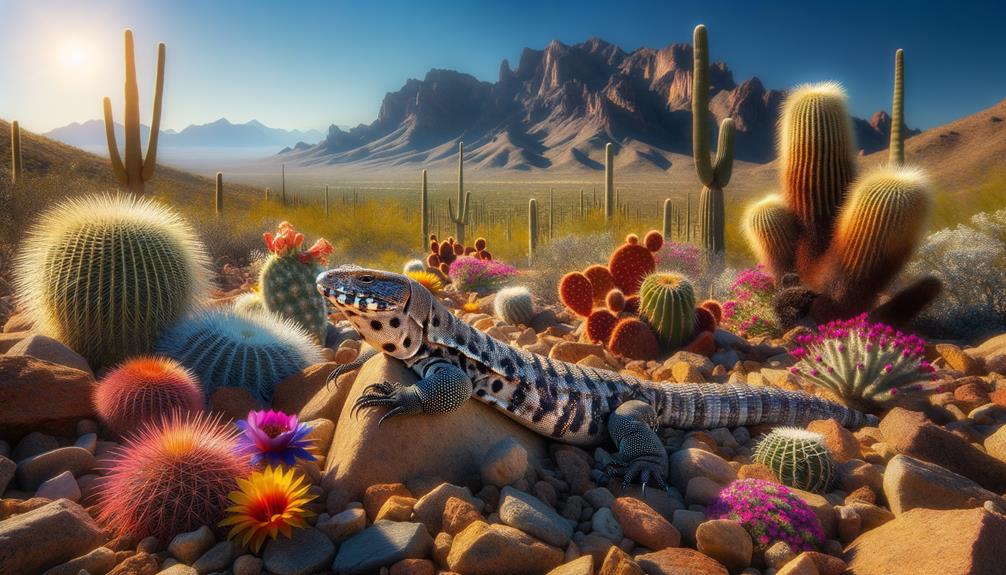I'm fascinated by the remarkable adaptations of Gobi Desert reptiles, which have made them masters of survival. The Gobi sand lizard's flattened body allows it to move stealthily, while the Gobi racerunner can reach speeds of up to 25 mph to evade predators. Gobi geckos have developed specialized toe pads for climbing, and thorny dragons have spiny skin to protect themselves from the harsh sun. These reptiles conserve water through efficient kidneys and minimize their activity during peak heat. The Gobi agama even stores fat in its tail to survive food shortages. There's still much to learn about these incredible reptiles and their remarkable ability to thrive in the harsh Gobi environment.
Key Takeaways
Gobi reptiles have developed unique adaptations to survive the extreme temperatures of their habitat. Their thick, spiny skin and burrowing abilities help them endure the harsh conditions.
To conserve water, Gobi reptiles have efficient kidneys, store water in their bladders, and minimize water loss through their scaly skin.
The Gobi racerunner's impressive speed of up to 25 mph helps it evade predators and avoid the heat.
Gobi agama lizards store fat in their tails, allowing them to survive during periods of food scarcity.
Gobi sand lizards use camouflage and stealth to effectively evade predators.
Unique Adaptations of Gobi Reptiles
In the Gobi Desert, reptiles have developed remarkable adaptations to survive the harsh environment. The Gobi sand lizards, for instance, have flattened bodies that enable them to slide effortlessly between rocks and vegetation, evading predators with stealthy precision. Their slender bodies are built for speed and agility, gliding through the desert landscape to escape danger.
The Gobi racerunner is another marvel, capable of reaching speeds of up to 15 mph, or 22 feet per second. This incredible velocity allows them to outrun threats in the scorching desert heat. Imagine the rush of moving at such speeds across the hot sand, every muscle working in tandem to ensure survival.
Gobi geckos possess specialized toe pads that enable them to climb steep, rocky outcrops with ease. They navigate their rugged terrain in search of insects and spiders, their agility a testament to their adaptability. Meanwhile, Gobi thorny dragons sport thick, spiny skin, a perfect shield against the harsh desert sun.
Lastly, Gobi ratsnakes have mastered the art of burrowing underground. This adaptation provides a refuge from the oppressive daytime heat and offers ample hunting opportunities for small rodents.
Water Conservation Techniques

I've always been fascinated by the incredible water conservation techniques used by Gobi reptiles. These remarkable creatures have adapted to survive in one of the harshest environments on Earth, where water is scarce. From absorbing moisture through their skin to seeking shade during the hottest part of the day, they've developed clever ways to conserve every precious drop.
Efficient Water Storage
In the harsh Gobi Desert, reptiles have developed remarkable water conservation techniques to survive. These adaptations showcase nature's ingenuity in extreme environments.
To minimize water loss, their specialized scales act as tiny armor plates, shielding their bodies from the relentless desert heat. Many Gobi reptiles can absorb water directly through their skin, a rare and efficient method of hydration. Some species store water in their bladders for extended periods, using it sparingly as needed. Their kidneys are also incredibly efficient at reabsorbing water from waste, ensuring minimal loss.
These adaptations highlight the reptiles' resilience and underscore their remarkable ability to thrive in an unforgiving environment. By mastering these strategies, Gobi reptiles not only survive but flourish, embodying the spirit of independence and adaptability in one of the harshest environments on Earth.
Minimal Hydration Needs
Desert reptiles have developed remarkable water conservation techniques, allowing them to survive in the arid Gobi landscape with minimal hydration. One fascinating example is the thorny devil, whose skin uses capillary action to draw water towards its mouth, effectively allowing it to drink through its skin. This adaptation ensures it stays hydrated even with scarce water sources.
In the harsh Gobi environment, reptiles must maximize every drop of water they encounter. The wild Bactrian camel, though not a reptile, provides a compelling parallel; it eats snow to stave off thirst. This highlights the extreme measures creatures in arid environments take to conserve water.
Reptiles' physiological adaptations are remarkable. Their kidneys are highly effective at reabsorbing water, producing highly concentrated urine to minimize water loss. Their scaly skin reduces evaporation. These adaptations are crucial for their survival in one of the planet's most unforgiving climates.
Understanding these creatures' minimal hydration needs provides insight into their resilience. They thrive in environments where life seems impossible, exemplifying the spirit of freedom. These water conservation techniques are a testament to their evolutionary ingenuity.
Behavioral Adaptations
In addition to their remarkable physiological adaptations, reptiles in the Gobi desert have developed extraordinary behavioral adaptations to conserve water and enhance their survival in this harsh environment. Each species has evolved unique strategies to minimize water loss and maximize their chances of survival.
One remarkable example is the Thorny Devil's skin capillary action, which allows it to absorb water through its skin, channeling moisture from any surface directly to its mouth. This adaptation is vital for hydration in an environment where liquid water is scarce.
The Saharan silver ant's foraging schedule is another prime example of water conservation. By venturing out for only ten minutes a day to scavenge, it minimizes water loss and heat exposure, offering a valuable lesson in survival for desert dwellers.
The fennec fox, with its oversized ears, efficiently dissipates heat and uses its acute hearing to locate scarce prey. Although a mammal, its adaptation highlights the importance of behavioral traits in desert survival.
The desert long-eared bat's venom resistance is another fascinating example. By preying on venomous scorpions, it exploits a food source that others avoid, ensuring a steady diet and reducing the need to hunt more frequently, thereby conserving water.
These remarkable behaviors demonstrate the ingenuity of desert life in conserving water and thriving against the odds.
Temperature Regulation Strategies
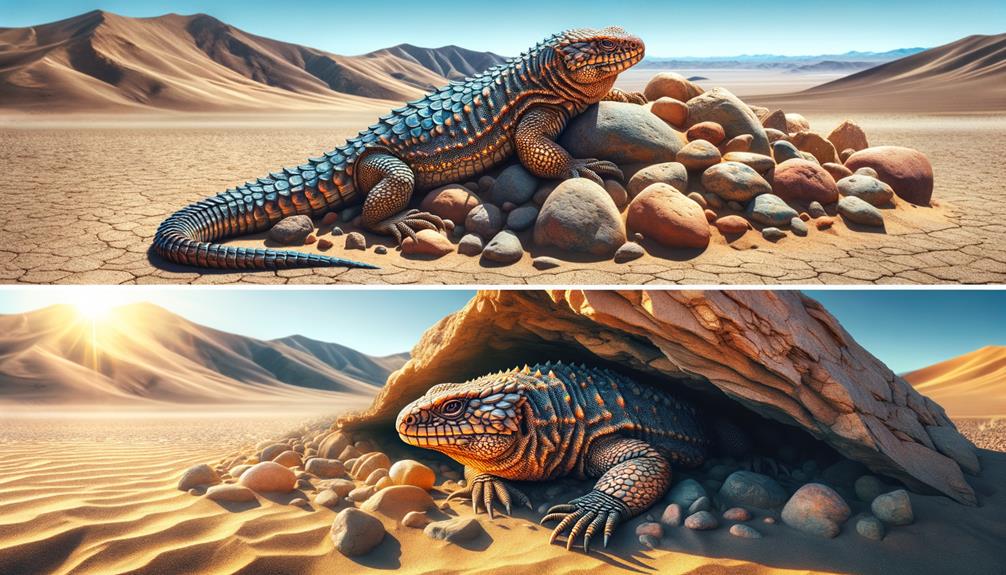
Desert reptiles have mastered the art of temperature regulation, employing a dual approach to survive the harsh conditions of their arid habitats. They burrow underground to escape blistering surface heat and bask on sun-warmed rocks to soak up essential solar radiation. For instance, the thorny devil in Australia has developed a remarkable method to hydrate in dry environments. It can absorb water through its skin via capillary action, ensuring it stays hydrated even when water sources are scarce.
In the Sahara Desert, the Saharan silver ant has developed a unique strategy to avoid extreme midday heat. These ants venture out of their nests for only about ten minutes each day, timing their foraging activities to the cooler parts of the day. This brief window minimizes their exposure to potentially lethal temperatures.
These adaptations highlight the incredible resilience and resourcefulness of desert reptiles. They've evolved to thrive in environments where survival seems impossible. From thermoregulation through behavioral adaptations to physiological marvels, these creatures embody a remarkable balance with their unforgiving environments. This balance is a testament to nature's relentless drive for survival and the freedom found in life's pursuit of equilibrium.
Predator Evasion Tactics
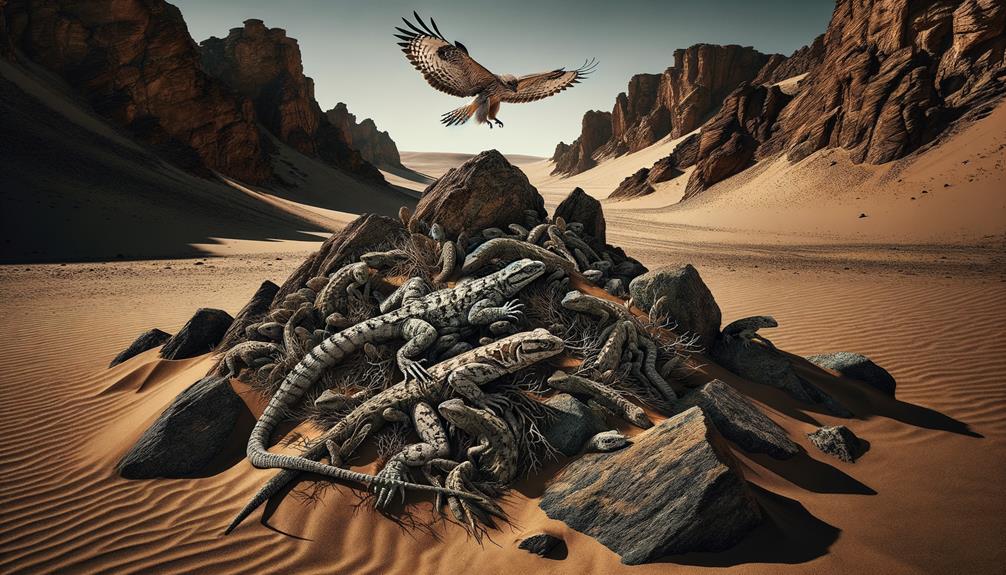
In the harsh desert landscape, survival depends on more than just enduring the elements. Creatures must also evade the many predators lurking in the shadows. To stay alive, desert dwellers have developed remarkable strategies to avoid predators. Let's delve into the fascinating ways they thrive in these harsh conditions.
- Thorny Devil Lizards: These Australian desert natives sport spiky scales that serve two purposes: defense and water collection. The spines channel moisture directly to their mouths, allowing them to stay hydrated while blending into their rugged surroundings to avoid predators.
- Saharan Silver Ants: These ants venture out of their nests for only 10 minutes a day, capitalizing on the extreme Saharan heat that deters most predators. Their brief daily excursions are a calculated risk to gather food while minimizing exposure.
- Fennec Foxes: With their oversized ears, these Sahara natives excel in detecting both prey and predators. Their acute hearing gives them an edge, allowing them to evade threats long before they come too close.
- Roadrunners: Found in the southern United States and Mexico, these birds prefer running at speeds of up to 20 mph to escape predators, demonstrating that flight isn't always the best option for evasion.
These tactics showcase the incredible adaptability of desert inhabitants.
Notable Gobi Reptile Species
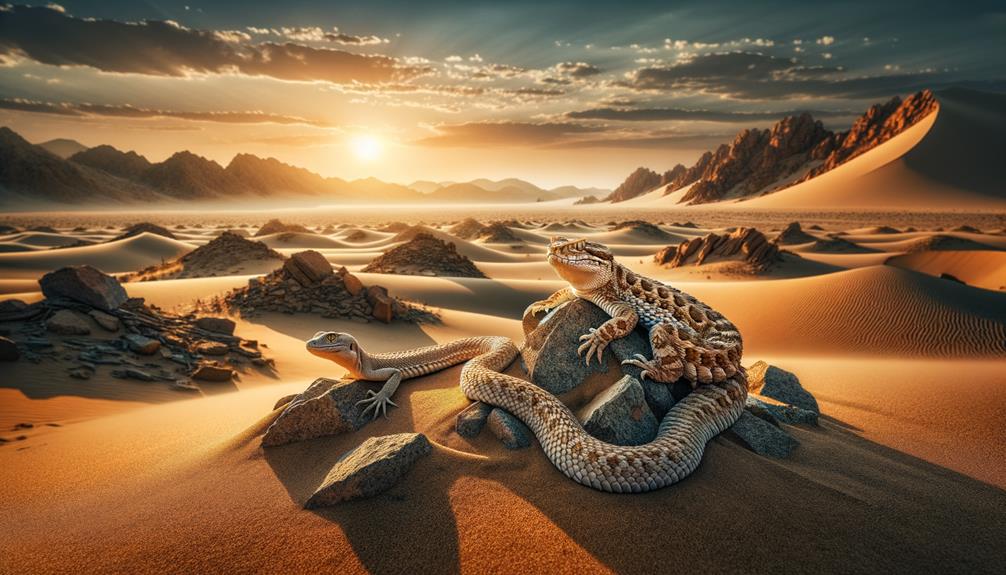
As we delve into the remarkable adaptations of desert reptiles, the Gobi Desert offers a fascinating array of species that have evolved unique traits to thrive in one of the harshest environments on Earth. The Gobi racerunner, for instance, can reach speeds of up to 25 mph, allowing it to swiftly evade predators and escape the desert's intense heat. This incredible agility is a testament to the importance of speed in survival.
The Gobi agama, a small, spiny-bodied lizard, stores fat in its tail, providing an essential energy reserve during periods of food scarcity, a common challenge in such an arid landscape. This adaptation is like carrying a personal food supply wherever it goes.
Mongolian cobras, another notable species, have developed the ability to conserve water by reducing their activity during the hottest parts of the day. They rely on their venom to subdue prey, ensuring they don't waste precious energy or moisture.
Survival Challenges in the Gobi
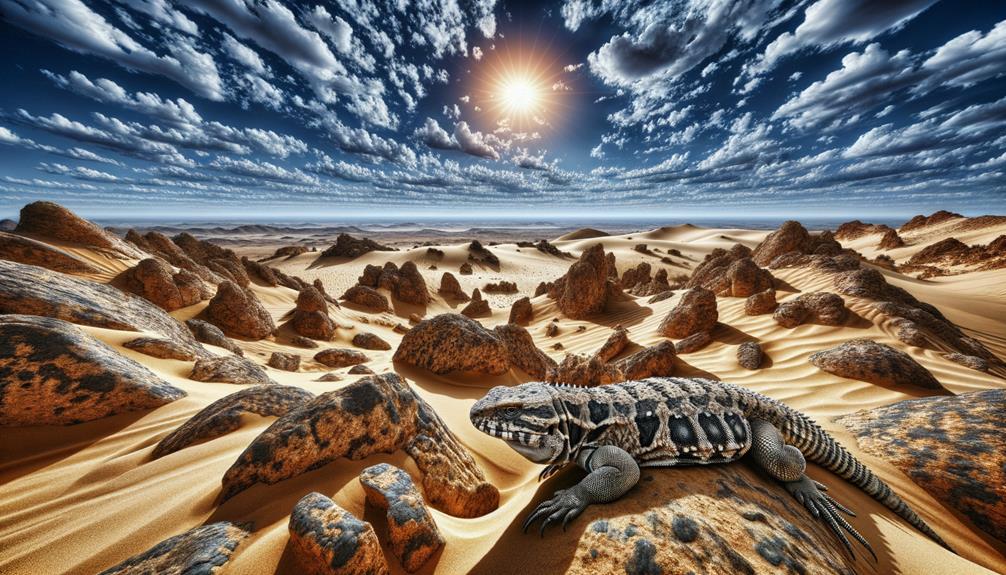
Surviving in the Gobi Desert requires remarkable adaptations to cope with its extreme temperature fluctuations and scarce water sources. During the day, temperatures can soar to scorching highs, while nights plunge to freezing lows. Reptiles here have developed fascinating strategies to endure these harsh conditions.
To thrive in such an unforgiving environment, Gobi reptiles need to employ several key strategies:
- Conserve Water: With water sources scarce, reptiles like the Thorny Devil have evolved to extract water through their skin, maximizing hydration from even the tiniest moisture available.
- Regulate Body Temperature: Insulating features, such as the Sandcat's paw fur, help creatures navigate the blistering sand without burning their feet, while also retaining heat during the cold nights.
- Optimize Energy Usage: Energy conservation is crucial. Reptiles minimize movement during the hottest parts of the day, emerging only during cooler periods to forage and hunt.
- Adapt Foraging Habits: The Saharan Silver Ant, for example, can sprint at incredible speeds, allowing it to forage quickly during the intense midday heat, reducing exposure to predators and the sun's rays.
These adaptations highlight the incredible resilience of Gobi reptiles, showcasing their ability to conquer one of Earth's most challenging habitats.
Frequently Asked Questions
What Do Desert Animals Need to Survive?
Desert animals have evolved unique adaptations to survive in extreme environments. For instance, the fennec fox's oversized ears help it dissipate heat, while the Saharan silver ant's brief foraging sessions minimize water loss.
How Many Desert Animals Are There?
When it comes to desert animals, the numbers are staggering. From hundreds to thousands, these creatures have evolved remarkable adaptations to survive in harsh environments, showcasing remarkable resilience.
Which Animals Live in the Desert?
I find the desert teeming with life – sandcats use rapid blows to hunt, thorny devils absorb water through their skin, Saharan silver ants scavenge in extreme heat, fennec foxes dissipate heat with their oversized ears, and long-eared bats prey on scorpions.
What Do Desert Animals Eat?
Desert animals have unique diets that help them survive in the harsh environment. For instance, sandcats prey on small snakes, while bats feed on scorpions. The thorny devil, a type of lizard, absorbs water through its skin to stay hydrated. Each species has evolved to thrive in its own way, demonstrating remarkable adaptability in the desert's extreme conditions.



